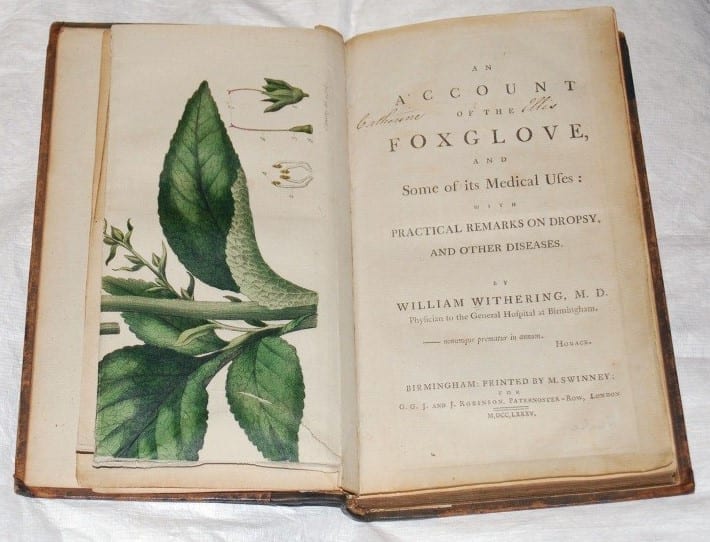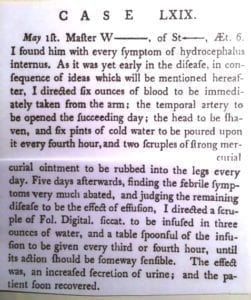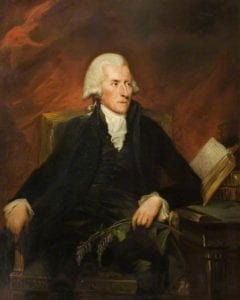Göran Wettrell
Sweden
 |
| Fig. 1. Title page of William Withering’s An Account of the Foxglove and Some of its Medical Uses, 1785. P. I. Nixon Medical History Library. UT Health Science Center, San Antonio. |
William Withering’s An Account of the Foxglove and some of its Medical Uses was published in 1785.1 The book received great attention and was the result of several years of clinical observations. On the title page, Withering chose a quotation from the Ars Poetica of Horace: nonumque permatur in annum, “let it be suppressed for nine years.” He collected his clinical cases between 1775 and 1784, compiling studies of 163 patients treated with digitalis. The book also included thirteen confirmatory reports from friends and colleagues of another fifty-five patients on digitalis.1,2
In 1775 Withering started to use a mixture of herbs as a decoction to cure dropsy. He soon found out that the active herb was foxglove and that the action of digitalis was mostly a diuretic one.2 He also observed that digitalis had “a power over the motion of the heart to a degree yet unobserved in any other medicine and that this power may be converted to salutary ends.”2 The foxglove in Withering’s cases of dropsy had a therapeutic efficacy of around 65 to 80%.2 However, almost no efficacy was reported for two conditions, ovarium dropsy (ovarian cysts) and tuberculosis. After 1776 Withering gradually used foxglove more in the form of powdered leaves, which produced fewer side effects such as nausea, vomiting, and diarrhea.2
Among Withering’s carefully presented cases were twelve children treated with digitalis.1,3 The drug was used in young patients between three to fifteen years of age for a variety of diseases such as scrofula, epilepsy, ascites, anasarca, dropsy, and hydrocephalus. Withering commented in seven out of the twelve pediatric reports “that digitalis may be used with advantage in every species of dropsy except the encysted.” He also wrote about his observations in 1779: “that year we had many dropsies in children, who had suffered from the Scarlatina Anginosa; they all yielded very readily to the Digitalis, … I did not keep notes of these cases, but I do not recollect a single instance in which Digitalis failed to effect a cure.”2 On the other hand, no effects of digitalis were reported in scrofula or epilepsy.
 |
| Fig. 2. Case LXIX (1781), six-year-old boy with hydrocephalus. From An Account of the Foxglove. Private photo. |
Withering also prescribed digitalis to three young patients with hydrocephalus. In one of the children (Case LXIX, Figure 2), he reported a recovery but made the general remarks in the book “that I have not been able to determine whether Digitalis can or cannot be used with advantage in the second stage of the hydrocephalus … the Digitalis ought to be given in much larger doses in this, than in other diseases.”2
Today we know that during treatment, high digoxin content is found in the choroid plexus of the brain, the mediator of cerebrospinal production. The cardiac glycosides in higher doses might also inhibit cerebrospinal production.4,5 In infants with hydrocephalus, digoxin therapy has been used to attempt to reduce cerebrospinal fluid production. This decrease might be sufficient in selected cases, but seems to have only marginal influence overall.5
 |
| Fig. 3. William Withering, portrait by Carl Fredrik von Breda, 1792, oil painting. Nationalmuseum, Stockholm. |
In 1776, Withering’s knowledge of botany was sufficient to publish the first edition of a botany work entitled Botanical Arrangements of all the Vegetables naturally growing in Great Britain with Descriptions of the Genera and Species According to Linnaeus. The Linnean system of classification was used and Withering’s book was widely welcomed. He joined the Lunar Society of Birmingham in 1776 and was elected a fellow of the Linnean Society in 1787.2 One statement in this first edition of the Botany focused on digitalis: “It is certainly a very active medicine and merits more attention than modern practice bestows upon it.”2 In the painting of Withering by the Swedish artist Carl Fredrik von Breda in 1792 (Figure 3), Withering is seen with a foxglove in his hand and a copy of the Botany on his left. It is the second volume of the second edition (1787) of the book showing the above-mentioned statement about digitalis.
The expertise Withering had gained in his early studies of botany came to be of major importance in his successful clinical use of foxglove. It is an illustration to the proverb of Louis Pasteur (1854) that “chance favors the prepared mind.” Withering seems to be the first to record the use of digitalis in children. He was fully aware that more research on foxglove in general would be required. He wrote in the preface of An Account of the Foxglove: “After all, in spite of opinion, prejudice, or error, Time will fix the real value upon this discovery, and determine whether I have imposed upon myself and others, or contributed to the benefit of science and mankind.”1,2 Over the years until his death in 1799, Withering gained a continental reputation as a botanist, a physician, a chemist/geologist, and a philosopher.
References
- Withering, W. An Account of the Foxglove and Some of its Medical Uses. Facsimile for the Classics of Medicine Library, Gryphon Editions, New York, 1979.
- Aronson, J. An Account of the Foxglove and its Medical Uses 1785 – 1985. Oxford University Press, 1985.
- Goldring, D. Withering´s Account of Foxglove and its use in children. Pediatrics.1973; 3: 549-550.
- Bertler, Å, Andersson, K.E. and Wettrell, G. Concentration of digoxin in choroid plexus. Lancet. 1973; 2: 1453-1454.
- Allonen, H., Andersson, K.E., Isalo, E., Kanto, J., Strömblad, L.G. and Wettrell, G. Passage of Digoxin into Cerebrospinal Fluid in Man. Acta pharmacol. et toxicol. 1977; 41: 193-202.
GÖRAN WETRELL is an Associate Professor and Senior Consultant in Paediatric Cardiology and Paediatrics at Lund University, Sweden with interest in pediatric pharmacology, molecular genetics, and primary arrhythmias. Other interests include male choir singing, travelling, and medical history.
Highlighted in Frontispiece Volume 11, Issue 2– Spring 2019
Winter 2019 | Sections | Physicians of Note

Leave a Reply